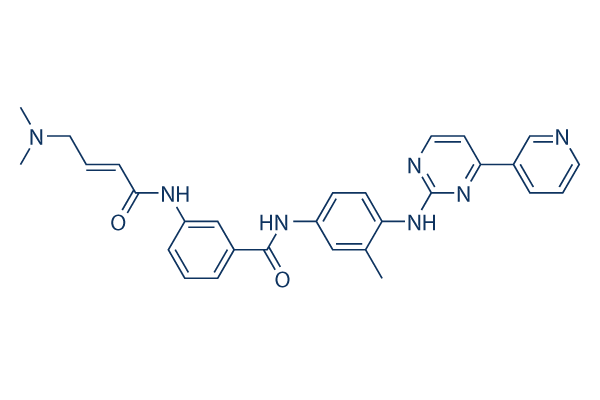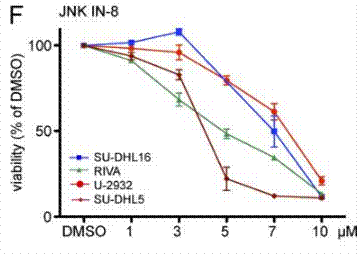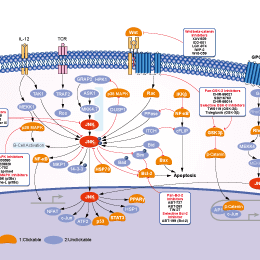
- Bioactive Compounds
- By Signaling Pathways
- PI3K/Akt/mTOR
- Epigenetics
- Methylation
- Immunology & Inflammation
- Protein Tyrosine Kinase
- Angiogenesis
- Apoptosis
- Autophagy
- ER stress & UPR
- JAK/STAT
- MAPK
- Cytoskeletal Signaling
- Cell Cycle
- TGF-beta/Smad
- DNA Damage/DNA Repair
- Compound Libraries
- Popular Compound Libraries
- Customize Library
- Clinical and FDA-approved Related
- Bioactive Compound Libraries
- Inhibitor Related
- Natural Product Related
- Metabolism Related
- Cell Death Related
- By Signaling Pathway
- By Disease
- Anti-infection and Antiviral Related
- Neuronal and Immunology Related
- Fragment and Covalent Related
- FDA-approved Drug Library
- FDA-approved & Passed Phase I Drug Library
- Preclinical/Clinical Compound Library
- Bioactive Compound Library-I
- Bioactive Compound Library-Ⅱ
- Kinase Inhibitor Library
- Express-Pick Library
- Natural Product Library
- Human Endogenous Metabolite Compound Library
- Alkaloid Compound LibraryNew
- Angiogenesis Related compound Library
- Anti-Aging Compound Library
- Anti-alzheimer Disease Compound Library
- Antibiotics compound Library
- Anti-cancer Compound Library
- Anti-cancer Compound Library-Ⅱ
- Anti-cancer Metabolism Compound Library
- Anti-Cardiovascular Disease Compound Library
- Anti-diabetic Compound Library
- Anti-infection Compound Library
- Antioxidant Compound Library
- Anti-parasitic Compound Library
- Antiviral Compound Library
- Apoptosis Compound Library
- Autophagy Compound Library
- Calcium Channel Blocker LibraryNew
- Cambridge Cancer Compound Library
- Carbohydrate Metabolism Compound LibraryNew
- Cell Cycle compound library
- CNS-Penetrant Compound Library
- Covalent Inhibitor Library
- Cytokine Inhibitor LibraryNew
- Cytoskeletal Signaling Pathway Compound Library
- DNA Damage/DNA Repair compound Library
- Drug-like Compound Library
- Endoplasmic Reticulum Stress Compound Library
- Epigenetics Compound Library
- Exosome Secretion Related Compound LibraryNew
- FDA-approved Anticancer Drug LibraryNew
- Ferroptosis Compound Library
- Flavonoid Compound Library
- Fragment Library
- Glutamine Metabolism Compound Library
- Glycolysis Compound Library
- GPCR Compound Library
- Gut Microbial Metabolite Library
- HIF-1 Signaling Pathway Compound Library
- Highly Selective Inhibitor Library
- Histone modification compound library
- HTS Library for Drug Discovery
- Human Hormone Related Compound LibraryNew
- Human Transcription Factor Compound LibraryNew
- Immunology/Inflammation Compound Library
- Inhibitor Library
- Ion Channel Ligand Library
- JAK/STAT compound library
- Lipid Metabolism Compound LibraryNew
- Macrocyclic Compound Library
- MAPK Inhibitor Library
- Medicine Food Homology Compound Library
- Metabolism Compound Library
- Methylation Compound Library
- Mouse Metabolite Compound LibraryNew
- Natural Organic Compound Library
- Neuronal Signaling Compound Library
- NF-κB Signaling Compound Library
- Nucleoside Analogue Library
- Obesity Compound Library
- Oxidative Stress Compound LibraryNew
- Plant Extract Library
- Phenotypic Screening Library
- PI3K/Akt Inhibitor Library
- Protease Inhibitor Library
- Protein-protein Interaction Inhibitor Library
- Pyroptosis Compound Library
- Small Molecule Immuno-Oncology Compound Library
- Mitochondria-Targeted Compound LibraryNew
- Stem Cell Differentiation Compound LibraryNew
- Stem Cell Signaling Compound Library
- Natural Phenol Compound LibraryNew
- Natural Terpenoid Compound LibraryNew
- TGF-beta/Smad compound library
- Traditional Chinese Medicine Library
- Tyrosine Kinase Inhibitor Library
- Ubiquitination Compound Library
-
Cherry Picking
You can personalize your library with chemicals from within Selleck's inventory. Build the right library for your research endeavors by choosing from compounds in all of our available libraries.
Please contact us at info@selleckchem.com to customize your library.
You could select:
- Antibodies
- Bioreagents
- qPCR
- 2x SYBR Green qPCR Master Mix
- 2x SYBR Green qPCR Master Mix(Low ROX)
- 2x SYBR Green qPCR Master Mix(High ROX)
- Protein Assay
- Protein A/G Magnetic Beads for IP
- Anti-Flag magnetic beads
- Anti-Flag Affinity Gel
- Anti-Myc magnetic beads
- Anti-HA magnetic beads
- Poly DYKDDDDK Tag Peptide lyophilized powder
- Protease Inhibitor Cocktail
- Protease Inhibitor Cocktail (EDTA-Free, 100X in DMSO)
- Phosphatase Inhibitor Cocktail (2 Tubes, 100X)
- Cell Biology
- Cell Counting Kit-8 (CCK-8)
- Animal Experiment
- Mouse Direct PCR Kit (For Genotyping)
- New Products
- Contact Us
JNK-IN-8
Synonyms: JNK Inhibitor XVI
JNK-IN-8 (JNK Inhibitor XVI) is the first irreversible JNK inhibitor for JNK1, JNK2 and JNK3 with IC50 of 4.7 nM, 18.7 nM and 1 nM, >10-fold selectivity against MNK2, Fms and no inhibition to c-Kit, Met, PDGFRβin A375 cell line.

JNK-IN-8 Chemical Structure
CAS No. 1410880-22-6
Purity & Quality Control
Batch:
Purity:
99.16%
99.16
JNK-IN-8 Related Products
| Related Targets | JNK1 JNK2 JNK3 | Click to Expand |
|---|---|---|
| Related Products | SP600125 Anisomycin JNK Inhibitor IX Tanzisertib HCl(CC-930) JNK Inhibitor VIII BI-78D3 Bentamapimod (AS602801) DTP3 Polyphyllin I CC-401 Hydrochloride SP 600125, negative control | Click to Expand |
| Related Compound Libraries | Kinase Inhibitor Library MAPK Inhibitor Library Cell Cycle compound library TGF-beta/Smad compound library Anti-alzheimer Disease Compound Library | Click to Expand |
Signaling Pathway
Cell Data
| Cell Lines | Assay Type | Concentration | Incubation Time | Formulation | Activity Description | PMID |
|---|---|---|---|---|---|---|
| human HeLa cells | Function assay | 1 h | Inhibition of JNK3-mediated c-jun phosphorylation in human HeLa cells after 1 hr incubation, IC50=0.486 μM | 25415535 | ||
| human A375 cells | Function assay | 1 h | Inhibition of JNK3-mediated c-jun phosphorylation in human A375 cells after 1 hr incubation, IC50=0.338 μM | 25415535 | ||
| Click to View More Cell Line Experimental Data | ||||||
Biological Activity
| Description | JNK-IN-8 (JNK Inhibitor XVI) is the first irreversible JNK inhibitor for JNK1, JNK2 and JNK3 with IC50 of 4.7 nM, 18.7 nM and 1 nM, >10-fold selectivity against MNK2, Fms and no inhibition to c-Kit, Met, PDGFRβin A375 cell line. | ||||||||||
|---|---|---|---|---|---|---|---|---|---|---|---|
| Features | JNK-IN-8 and JNK-IN-7 are structurally very similar, but whereas the former is a specific covalent inhibitor of JNKs. | ||||||||||
| Targets |
|
| In vitro | ||||
| In vitro | JNK-IN-8 inhibits c-Jun phosphorylation in HeLa and A375 cells with EC50 of 486 nM and 338 nM, respectively. JNK-IN-8 shows a dramatic improvement in selectivity and eliminated binding to IRAK1, PIK3C3, PIP4K2C, and PIP5K3. JNK-IN-8 requires Cys116 for JNK2 inhibition. [1] JNK-IN-8 (10 mM) suppresses the IL-1β-stimulated phosphorylation of c-Jun in IL-1R cells, an established substrate of the JNKs. JNK-IN-8 covalently attaches to the JNK isoforms caused a small retardation in the electrophoretic mobility of the JNK isoforms. [2] JNK-IN-8 is discovered to inhibit JNK kinase by broad-based kinase selectivity profiling of a library of acrylamide kinase inhibitors based on the structure of using the KinomeScan approach. JNK-IN-8 possesses distinct regiochemistry of the 1,4-dianiline and 1,3-aminobenzoic acid substructures. JNK-IN-8 adopts an L-shaped type I binding conformation to access Cys 154 located toward the lip of the ATP-binding site. [3] |
|||
|---|---|---|---|---|
| Kinase Assay | Binding Kinetics Assay | |||
| Binding kinetics assay A375 cells are pretreated with 1 μM JNK-IN-8 for the indicated amounts of time. Remove the medium and wash three times with PBS. Resuspend the cell pellet with 1 mL Lysis Buffer (1% NP-40, 1% CHAPS, 25 mM Tris, 150 mM NaCl, Phosphatase Inhibitor Cocktail, and Protease Inhibitor Cocktail). Rotate end to end for 30 min at 4℃. Lysates are cleared by centrifugation at 1.4×104 rpm for 15 min in the Eppendorf. The cleared lysates are gel filtered into Kinase Buffer (0.1% NP-40, 20 mM HEPES, 150 mM NaCl, Phosphatase Inhibitor Cocktail, Protease Inhibitor Cocktail) using 10DG columns. The total protein concentration of the gel-filtered lysate should be around 5–15 mg/ml. Cell lysate is labeled with the probe from ActivX at 5 μM for 1 hour. Samples are reduced with DTT, and cysteines are blocked with iodoacetamide and gel filtered to remove excess reagents and exchange the buffer. Add 1 vol of 2× Binding Buffer (2% Triton-100, 1% NP-40, 2 mM EDTA, 2× PBS) and 50 μL streptavidin bead slurry, and rotate end to end for 2 hours, centrifuge at 7,000 rpm for 2 min. Wash three times with 1× Binding Buffer and three times with PBS. Add 30 μL 1× sample buffer to beads; heat samples at 95℃ for 10 min. Run samples on an SDS-PAGE gel at 110V. After transferred, the membrane is immunoblotted with JNK antibody. | ||||
| Experimental Result Images | Methods | Biomarkers | Images | PMID |
| Western blot | Notch1 / c-Myc / Cyclin D1 / p21 c-Jun / p-c-Jun / ATF2 / p-ATF2 / Elk-1 / pElk-1 |

|
27941886 | |
| Growth inhibition assay | Cell viability |

|
25847947 | |
| In Vivo | ||
| In vivo | JNK-IN-8 is a potent JNK inhibitor that specially targets JNK activation. It has anti-fungal activity. |
|
|---|---|---|
| Animal Research | Animal Models | C57BL/6 mice |
| Dosages | 10 mg/kg | |
| Administration | i.p. | |
|
Chemical Information & Solubility
| Molecular Weight | 507.59 | Formula | C29H29N7O2 |
| CAS No. | 1410880-22-6 | SDF | Download JNK-IN-8 SDF |
| Smiles | CC1=C(C=CC(=C1)NC(=O)C2=CC(=CC=C2)NC(=O)C=CCN(C)C)NC3=NC=CC(=N3)C4=CN=CC=C4 | ||
| Storage (From the date of receipt) | |||
|
In vitro |
DMSO : 100 mg/mL ( (197.0 mM) Moisture-absorbing DMSO reduces solubility. Please use fresh DMSO.) Water : Insoluble Ethanol : Insoluble |
Molecular Weight Calculator |
|
In vivo Add solvents to the product individually and in order. |
In vivo Formulation Calculator |
|||||
Preparing Stock Solutions
Molarity Calculator
In vivo Formulation Calculator (Clear solution)
Step 1: Enter information below (Recommended: An additional animal making an allowance for loss during the experiment)
mg/kg
g
μL
Step 2: Enter the in vivo formulation (This is only the calculator, not formulation. Please contact us first if there is no in vivo formulation at the solubility Section.)
% DMSO
%
% Tween 80
% ddH2O
%DMSO
%
Calculation results:
Working concentration: mg/ml;
Method for preparing DMSO master liquid: mg drug pre-dissolved in μL DMSO ( Master liquid concentration mg/mL, Please contact us first if the concentration exceeds the DMSO solubility of the batch of drug. )
Method for preparing in vivo formulation: Take μL DMSO master liquid, next addμL PEG300, mix and clarify, next addμL Tween 80, mix and clarify, next add μL ddH2O, mix and clarify.
Method for preparing in vivo formulation: Take μL DMSO master liquid, next add μL Corn oil, mix and clarify.
Note: 1. Please make sure the liquid is clear before adding the next solvent.
2. Be sure to add the solvent(s) in order. You must ensure that the solution obtained, in the previous addition, is a clear solution before proceeding to add the next solvent. Physical methods such
as vortex, ultrasound or hot water bath can be used to aid dissolving.
Tech Support
Answers to questions you may have can be found in the inhibitor handling instructions. Topics include how to prepare stock solutions, how to store inhibitors, and issues that need special attention for cell-based assays and animal experiments.
Tel: +1-832-582-8158 Ext:3
If you have any other enquiries, please leave a message.
* Indicates a Required Field
Tags: buy JNK-IN-8 | JNK-IN-8 supplier | purchase JNK-IN-8 | JNK-IN-8 cost | JNK-IN-8 manufacturer | order JNK-IN-8 | JNK-IN-8 distributor







































